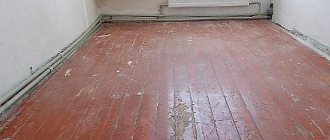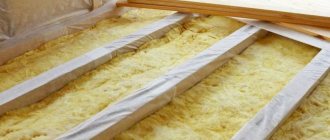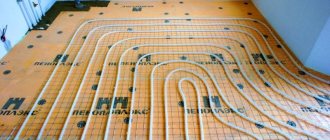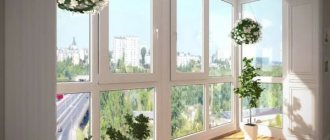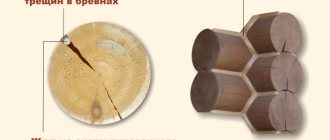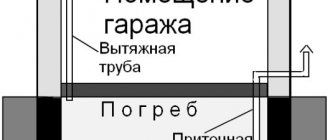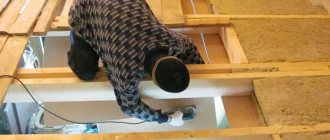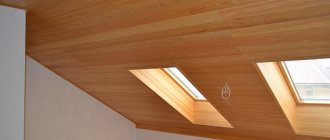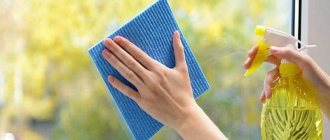Thermal insulation of apartments, especially in old buildings, often leaves much to be desired. First of all, this applies to floors in apartments located on the ground floor. As a rule, the room is separated from an unheated basement only by a concrete floor slab, which does not have good thermal insulation properties, which is why all the inhabitants of the apartment feel uncomfortable during the cold season. How to insulate the floor in an apartment yourself to save the situation and make your home warm and cozy?
What materials should be used for floor insulation?
There are various insulation options and a variety of insulation materials, the choice of which depends on the characteristics of the apartment and financial capabilities. What thermal insulation materials can be used to insulate the concrete floor of the first floor with your own hands?
First of all, such materials should be:
- Durable. After all, the floor is the surface that experiences the heaviest load in the apartment. Therefore, the insulation must withstand significant pressure.
If the selected type of thermal insulation does not have high strength, then you should choose a laying method that does not involve large loads on the thermal insulation material.
- Light. There is no need to create additional load on the floors. In addition, lightweight material is more porous, which means it retains heat better.
- Moisture resistant. The insulation should not lose its properties when wet or moistened, or should be protected by reliable waterproofing.
- Durable. It is advisable to carry out such a procedure as insulating a concrete floor only once during the entire period of residence in the apartment. It takes too much time, effort and money, even if everything is done with your own hands.
Note! Insulating the floor in an apartment almost always has a side effect in the form of reducing the height of the room due to the thickness of the insulation.
Do I need to put underlayment under linoleum?
As already mentioned, this flooring is widely popular. So in what cases is it necessary to lay an insulating substrate under linoleum? What materials are best to use?
Each case is individual, it all depends on the flooring material, which affects which material to choose and the method of insulation. The floor on which the apartment is located, because the floors of the first floors in apartment buildings are much colder. The greatest heat loss can occur through an uninsulated base.
Therefore, in apartments on the lower floors and private houses, it is necessary to use polystyrene foam and polystyrene foam for thermal insulation. In other cases, it will be enough to lay a felt, cork backing or rolled penofol.
How to insulate the floor in an apartment?
Let's consider which materials will be most preferable in the case of insulation of the concrete floor of the first floor.
- Expanded clay. Some time ago, this material was quite often used for floor insulation. Its main disadvantages are low moisture resistance and a fairly large thickness of the thermal insulation layer.
- Perlite. It surpasses expanded clay in thermal insulation properties, but is heavier.
- Expanded polystyrene or polystyrene foam. Very convenient for do-it-yourself floor insulation. They are not afraid of water, rodents and microorganisms, absolutely harmless. However, polystyrene foam is quite fragile and less durable than polystyrene foam boards.
- Mineral wool. Do-it-yourself insulation of a concrete floor is most often carried out using this particular material. In addition to thermal insulation properties, it also has good sound insulation, is light in weight and has a relatively low price.
USEFUL INFORMATION: How to attach joists to a concrete floor
The use of mineral wool for floor insulation involves the construction of a frame made of logs and the mandatory use of waterproofing, since when wet, mineral wool loses its properties.
- Cork based insulation. It has excellent qualities, but due to its high cost it is used quite rarely.
Insulation for concrete floors
The thermal insulation of the floor directly depends on the insulation you choose - this is a law that you cannot argue with. Because all heat insulators differ from each other in technical and operational characteristics, as well as in the place where they can be used. And it, in turn, depends on the operational characteristics of the room.
So how to insulate the floor in an apartment? What should you pay special attention to when choosing insulation?
- High strength index. The floor is the most loaded element of the room, which means that the load on the thermal insulation layer will be the greatest.
- Density of the material. Firstly, this indicator will affect weight. The lower the density, the lower the weight. And this is very good. Secondly, it affects the porosity of the material. The lower the density, the higher the porosity, which means the higher the thermal insulation properties.
- Thermal conductivity. This coefficient should be as low as possible.
- Moisture resistance. Of course, this indicator plays an important role. But we note that the choice based on it will largely depend on the room in which the floor insulation is carried out with your own hands. If it is a bathroom, toilet, balcony or kitchen, then, without a doubt, moisture resistance will be of great importance. In other rooms this is not so important.
- Moisture permeability. Some may think that this characteristic is the same as the previous one. Don't confuse them! Moisture permeability is the ability of a material to absorb moisture. Again, the lower this property, the better the insulation.
- Long-lasting operation. Everything here is clear and without words - the longer, the better.
- Environmentally friendly. Currently, special attention is paid to the environmental friendliness of any building materials. This affects the quality of housing and meets the requirements of modern times. So be sure to pay attention to this indicator.
Methods for insulating floors
To insulate a concrete floor on the first floor, it is not enough to simply lay warm linoleum or thick carpet on the floor. There are three options with which you can solve the problem of floor insulation:
- using sheets of plywood or chipboard;
- concrete screed over the insulation layer;
- using a lag structure.
Each of these methods has its own advantages and disadvantages. But regardless of the choice of option, it is necessary to follow the general principles of laying thermal insulation.
- The old floor covering must be removed. Ideally, you need to get to the concrete floor slab. If this is difficult to do, for example, ceramic tiles are laid on the floor, then linoleum or carpet with a thick backing can be laid on chipboards without removing the tiles. The main thing is that the surface is smooth. But it is better to dismantle wooden coverings before insulating the floor, so as not to encounter problems in the future.
- Floor insulation must include mandatory waterproofing. Concrete is famous for its ability to pass and even attract water. Therefore, it is necessary to reliably protect the room from moisture penetration.
- The surface must be leveled before laying insulation. This is easier to do at the initial stage than later leveling the floor with lags or screed.
Insulation of a concrete floor: options for resolving the issue
Categories: Articles
In terms of insulation, a concrete floor is the most problematic - this is affected by the characteristics of the material from which it is made. With equal success, concrete heats up very quickly and just as instantly gives off this heat to other surfaces or the air - it can be made a little warmer, but it is quite difficult to walk on it barefoot. Without forced heating, it is almost impossible to achieve such an effect. In this article we will talk about how concrete floor insulation is carried out - we will look at various options for solving this issue, among which you can choose the most suitable technology for yourself, it will help make your concrete floor a little warmer.
Insulation using chipboard or plywood
This is the fastest and easiest way to insulate the floor in an apartment, which does not involve the use of special insulation. Using it, you can make a thermal insulation substrate with your own hands in a short time before laying linoleum or carpet. However, it must be borne in mind that this method cannot be called an ideal option for insulating the floor of an apartment located on the ground floor, since it provides a relatively low level of thermal insulation. Floor insulation work is carried out in the following sequence:
- The old base is cleaned of dirt and dust.
- To ensure waterproofing, a layer of polyethylene film is laid on the base, the joints of which are taped.
- Before laying sheets of chipboard or plywood, it is necessary to create a thermal gap of 1.5–2 cm between them and the walls. This will avoid warping of the coating caused by the expansion of sheets with temperature changes.
- The coating slabs are laid in two layers offset from each other. Thus, the sheets of the top layer must overlap the seams formed between the slabs of the lower one. Dowels are used to fasten the sheets.
- The seams are treated with a solution of putty and oil paint. You can use reinforced mesh.
- A finishing coating in the form of carpet or linoleum is laid on the resulting substrate. You can simply press it down with baseboards. Another way is to glue the carpet to a thermal insulation backing using bustilate.
USEFUL INFORMATION: Features of the dry screed device
Insulation of concrete floor on the basement side
External insulation from the basement will work much more efficiently than internal insulation, and with the help of a suitable material it is not complicated. One of the most suitable insulation materials, primarily in terms of rigidity, is extruded polystyrene foam.
The required base must be level and clean . You can level it with glue for extruded polystyrene foam. Then glue is applied again, approximately 1 cm thick, and foam sheets are applied to the surface of the base.
They can also be additionally attached with special mushroom dowels . Penoplex sheets should fit tightly both to the surface and to each other. A reinforcing or fiberglass mesh is attached to the insulation, and then plastering is carried out.
Penoplex is not the only suitable material for insulating the floor on the basement side, but it is better that the material is solid.
Mineral wool is a soft material, it may be suitable, but then you will have to additionally install wooden logs or a galvanized profile on the surface, and be sure to lay a waterproofing film before installation.
Insulation under the screed
This method will require much more effort than insulation with chipboard sheets. But the thermal insulation that this method provides will be much better. Simultaneously with increasing the thermal insulation properties, the floor surface can also be leveled. How to insulate a concrete floor in an apartment under a screed?
- Initially, the existing covering is removed from the floor, preferably down to the concrete slab. After this, the surface is cleaned of dust and debris.
- A vapor barrier layer is laid that will prevent moisture from penetrating into the insulation. The vapor barrier film must be placed on the walls approximately 3–5 cm, and the joints must be taped.
- The insulation is laid tightly, and then another layer of vapor barrier is laid.
If polystyrene foam or expanded polystyrene is used as insulation, a second layer of vapor barrier can be omitted.
- A metal mesh is laid over the entire surface of the floor and attached around the perimeter of the room.
- The screed is being poured. The thickness of the concrete layer after drying must be at least 5 cm, otherwise such a substrate may simply not withstand the loads and crumble. The entire screed must be poured at one time, using a 200 grade solution, stirring the cement in the appropriate proportion.
- After the solution has dried, the surface is primed. The flooring is laid on top. It can be laminate, linoleum or carpet.
Technologies for installing various types of thermal insulation
Concrete floors always require additional treatment. Such measures include waterproofing, sound insulation and insulation. Sometimes, the materials used for insulation also have soundproofing properties. Thus, you not only insulate the floor, but also make your floor quieter.
How to properly insulate a concrete floor?
The answer to this question depends on the initial data:
- type of base;
- material type;
- floor height.
Thermal insulation under concrete screed
This method of insulation is suitable for installation in houses where there is no basement. In fact, thermal insulation material is laid on the compacted soil, and the floor cake is poured on top. In this case, the floor slab can be an independent element, or it can be part of the foundation.
This arrangement of the insulating layer can significantly save the budget, but the capabilities of the device are greatly limited, depending on the type of soil and the topography of the site.
If the initial data allows you to lay the insulation on the ground, then the instructions for the device are as follows:
- A layer of soil is removed to the required depth. The excavation of the lower layer should be done, trying to maintain the soil texture, as horizontal as possible.
- The soil on the site is carefully compacted and a gravel bed is filled. The thickness of the backfill is at least 10 cm. The backfill is compacted layer by layer.
- Sand is poured, preferably a fine fraction. The layer is spilled or compacted.
- Work is underway to pour a rough screed or foundation slab.
- The dried screed is treated with a deep penetration primer and laid with waterproofing material.
- A layer of thermal insulation is installed from roll or slab material.
- The film is covered with hydro- and vapor barrier. Please note that the film is laid with the metallized side facing the insulation.
- Finish filling is carried out, and if necessary, a reinforcing layer is installed.
- After drying, the finishing layer is poured.
On a note. When installing a concrete screed on the ground, you can lay foam boards before pouring the black screed. It is only important to reinforce the top layer of thermal insulation boards and lay waterproofing material.
Insulation of a concrete slab
How to insulate a concrete floor in an apartment?
When carrying out thermal insulation work inside an already used room, some nuances should be taken into account:
- The height of the ceilings in the room often limits the possibility of increasing the height of the insulating layer. Therefore, it is better to insulate a concrete floor in an apartment with polystyrene foam or mineral wool. These materials will allow you to avoid raising the floors significantly.
- You can also use slab penoizol, which in an apartment is laid on a concrete slab like parquet. Plates of this material have grooves and tenons for joining. You can secure the seams with tape to avoid possible movement of the sheets during further repair work.
- Taking into account the fact that apartments on the upper floors do not require enhanced thermal insulation, floor insulation on a concrete slab can be done using foiled polyethylene foam (penofol). The film is laid directly under the decorative finishing coating. Penofol should be laid with the metallized side up.
For a concrete floor in an apartment, penofol is also suitable as thermal insulation.
Before insulating a concrete floor in an apartment, you need to prepare the base:
- the overlap should not have significant flaws on the surface;
- the surface should be cleaned and dust free;
- concrete should be treated with a deep penetration primer.
Insulation by joists
The method of thermal insulation of the floor using joists is probably the most effective and reliable. Firstly, there is no need to perfectly level the screed. Secondly, this method makes it possible to use any available thermal insulation material.
Insulation of concrete floors with polystyrene foam on joists - mineral wool or expanded clay - will require equal costs for constructing the frame. Therefore, in this case, you can significantly save on insulation without changing the strength characteristics of the floor.
The video in this article will tell you how to properly insulate a floor on joists.
How to insulate concrete floors along joists with your own hands? It is necessary to fix wooden logs on a cement base.
The work order is as follows:
- A hydro- and vapor barrier film is laid on a rough concrete screed treated with a primer. The material is laid overlapping, the seams are carefully fixed with construction tape.
- The logs are being installed. For this, bars no more than 70 mm high are taken. The laying step is equal to the width of the thermal insulation material.
- The logs are leveled using a building level and fixed with anchors.
- Insulation is installed in the gap between the joists. When laying, avoid the formation of gaps between the insulation boards.
- The structure is covered with a film of hydro- and vapor barrier.
- The finished floor material or base for it is laid on top. Most often this is construction plywood.
Important! Wood used as logs must be pre-treated with antiseptic impregnation.
The laying of insulation material between the joists should be tight
Performing thermal insulation along joists
If the selected thermal insulation material is not able to withstand significant loads, then it is necessary to carry out insulation along the joists. For the design, even bars with a cross section of 50 by 100 mm are suitable, which it is highly advisable to pre-treat with an antiseptic solution. It will protect the logs from the penetration of fungus and extend their service life.
- After clearing the surface of debris, waterproof it. To do this, using a brush, you need to apply a layer of bitumen mastic, also covering the walls to a height of 5 cm.
- The logs are laid from timber; the first and last logs should be located close to the wall.
USEFUL INFORMATION: How to glue plywood to a concrete floor
Tip: in order to avoid unnecessary cutting of insulation material supplied in the form of rolls or sheets, the distance between the logs can be chosen equal to its width, but not more than 90 cm. When using bulk material, the rule applies: the thinner the logs, the smaller the distance between them .
- The laid logs are leveled and secured with anchors. You don’t have to fasten it if the beams rest securely against the wall.
- Having laid insulation between the joists, if necessary, lay a layer of vapor barrier and lay sheets of plywood or chipboard, fixing them with self-tapping screws on the joists. It is recommended to lay two layers, shifting them relative to each other. A gap of 1.5–2 cm is left between the sheets and the wall.
- A finishing coating, which is a laminate, carpet or linoleum, is laid on the substrate thus obtained.
Independent floor insulation on the first floor is not particularly difficult, and the variety of materials and technologies allows you to choose one of several methods that is most suitable in terms of labor costs and financial investments. Let your apartment always be warm and cozy!
How to check the quality of finished screed in a new building
The builders say the floor is ready for finishing. How can you check its quality without any special knowledge? There are some effective tips:
- Visual inspection. There should be no cracks or chips on the surface.
- Measurements. You will need a 2 meter long rail. It is applied to the floor. Standards allow gaps of no more than 2 mm for laying laminate, linoleum or parquet. If the screed is poured under the tiles, the gaps should not exceed 4-5 mm.
- Slope. The maximum permissible value is 2 cm per 10 meters.
- Strength. A wooden block is knocked on the surface of the screed. The sound should be ringing.
- Humidity. If the floor has not yet dried, you cannot start laying tiles or laminate. To check, attach a piece of polyethylene to the screed. After a day there should be no moisture on it.
If the above requirements are met, the screed is poured with high quality. It will last for several decades without replacement.
Method one: foam
The most common method today. This is a fairly inexpensive sound-absorbing heat insulator, which is very convenient to process and install. Its compressive strength depends on the density of the foam. Installation is quite easy. You just need to comply with some conditions.
Also read materials:
But first things first.
The quality of polystyrene foam as insulation
The main advantages of polystyrene foam:
- No drafts;
- Financial costs kept to a minimum;
- Ease of installation;
- Warm floor.
More than sixty percent of foam plastic in Europe is used for floor insulation.
What is polystyrene foam? White color gas-filled polymer. The polymer consists of tiny particles of foamed polystyrene, which is very often used in construction. It is excellent for insulating floors, which is successfully implemented in practice.
Those who believe that polystyrene foam is just granulated polystyrene foam, which usually crumbles into small balls, are deeply mistaken. There are polypropylene foam, polyurethane foam, polyethylene foam. They belong to the category of foam plastics. These are quite practical and similar in price materials.
To prevent moisture from entering, a thermal insulation layer is laid on top of the waterproofing
Ninety-seven percent of polystyrene foam consists of air bubbles - a natural heat insulator.
This insulation is produced in the form of sheets of different strength and thickness. To insulate the floor, PolaRemont.ru recommends purchasing material with profiled edges. In the future, this will allow you to get rid of the cold bridges that form between the foam panels in the cracks.
When foam is made, it is heated with water vapor. This provides a good level of moisture resistance. The material's immunity to moisture will work to its advantage in those houses that are located in an area where the groundwater level is high.
Expanded polystyrene (foam) has a cellular structure, retains heat well and resists moisture
